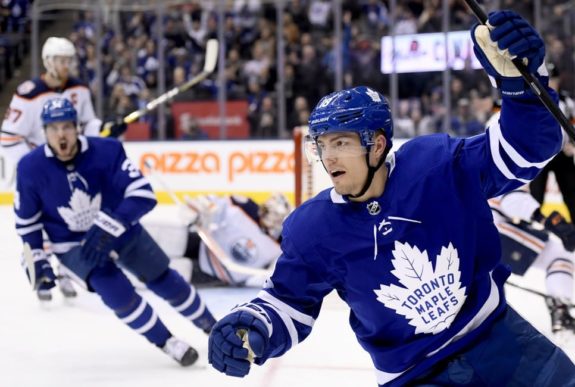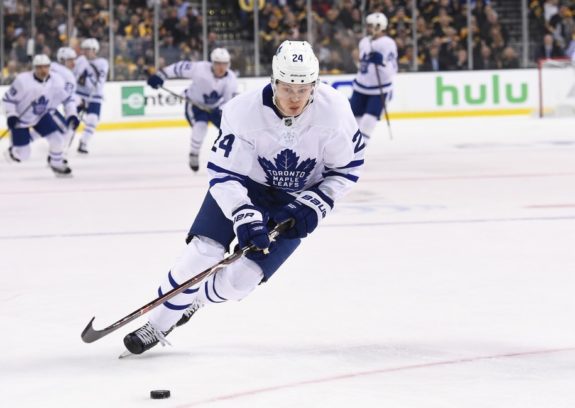There arguably hasn’t been a bigger topic of discussion this summer than the restricted free agent (RFA) stalemate. Some of hockey’s brightest young stars remain without contracts on the brink of September, otherwise known as the month that NHL training camps commence. Names like Mitch Marner, Mikko Rantanen, Matthew Tkachuk, Patrik Laine, Brayden Point, Zach Werenski, Kyle Connor, Brock Boeser and Charlie McAvoy headline a long list of RFAs that are currently unsigned for next season.
However, in the hockey mecca that is Toronto, the unrelenting chatter surrounds the stalemate between Mitch Marner and general manager Kyle Dubas. In fact, The Athletic’s Joe Smith opined that the Marner negotiations are clogging up the RFA market as fellow RFAs and their agents await a market-setting figure from Marner who led the RFA group in points with 94 last season, narrowly edging Point’s mark of 92.
“It appears there’s a waiting game among high-profile RFAs with no one wanting to go first, with a source saying agents are waiting for Toronto’s Mitch Marner to get a deal done and set the market.” (from ‘What the Andrei Vasilevskiy Contract Means for the Lightning’s Salary Cap – and Brayden Point’, The AthleticNHL – 7/29/19).
While the Marner negotiations continue to dominate hockey headlines into the end of summer, you may recall that Dubas came to terms with two vital in-house RFAs this summer in the form of Andreas Johnsson and Kasperi Kapanen. For what it’s worth, he also completed RFA deals with newly-acquired players in Alexander Kerfoot and Cody Ceci, but their expectations for next season can be found here. For now, let’s take a look at what we should expect from a couple of less-bandied about former RFAs in Johnsson and Kapanen as we approach the 2019-20 campaign.
Andreas Johnsson
At 24, Johnsson is a year older than Kapanen and his RFA contract term is a year longer at four years with a slightly higher cap hit at $3.4 million. A former seventh-round pick (202nd overall) from the 2013 draft, Johnsson has given the Maple Leafs tremendous value already. While he’s been valued within the organization for years, Johnsson gained external notoriety when he posted 54 points in as many games with the Maple Leafs’ AHL affiliate Toronto Marlies in the 2017-18 season before tallying 10 goals and 24 points across 16 postseason games en route to a Calder Cup championship and Playoff MVP honors.

His season didn’t end there, however, as Johnsson skated in the Maple Leafs final nine regular-season games, tallying two goals and one assist before skating in six playoff games that same year, notching a goal and an assist in the process.
In his first full NHL campaign last season, Johnsson produced 20 goals and 23 helpers for 43 points across 73 games. However, Johnsson came out of the gate slow with just one point in seven October contests, something that earned him some healthy scratches early in the season. The fleet-footed Swede found his groove in the month of December, however, notching nine points in 13 games for the month. All told, after his slow October and first half of November, Johnsson notched 35 points over his final 52 games of the season, good for a 0.67 point-per-game pace.
While he may not quite maintain that same pace this time around, I would expect something close to it. For one, Johnsson is likely set to flank Auston Matthews on the left side to start the season, a line that should also include William Nylander – one of the NHL’s top bounce-back candidates. Skating with a player in Matthews who leads the league in even-strength goals since entering the league in the 2016-17 is going to help Johnsson pad his assist totals in a top-six role.
Secondly, with Nazem Kadri no longer on the roster, the expectation is that Johnsson will fill his role on the Maple Leafs’ top power-play unit. This is a unit that also contains Matthews, John Tavares, Marner and Morgan Rielly – a star-studded group to say the least. Johnsson got some reps in with this unit last season, especially when Kadri was suspended in the playoffs. While he averaged 1:35 of power-play ice time last regular season and an increased 1:53 in the postseason, I would expect a jump over the two-minute mark this season. As a result, I would expect Johnsson’s six power-play points from last season to potentially double in 2019-20.
Johnsson was a 0.59 point-per-game player last season in largely third-line duties and second-unit power-play work. Throw him to the left of Matthews at even strength and on a first unit power-play group that could be among the top-five units in hockey, and a point-per-game increase is almost certain. While a notable jump in points is the expectation, I would expect all-round improvement somewhere in the 25-goal to 55-point range. On top of forechecking pressure and lights-out footspeed, that is the quantifiable expectation for Johnsson in 2019-20.
Kasperi Kapanen
As noted, Kapanen’s RFA deal is a year shorter than Johnsson’s and his cap hit is slightly cheaper as he inked a three-year deal with an annual cap hit of $3.2 million this summer. Despite being a year younger than Johnsson, Kapanen made his NHL debut two years earlier as he skated in nine NHL games with the Maple Leafs in the 2015-16 season, going pointless in the process.
The following season, Kapanen notched one goal in eight regular-season games before adding two more across six postseason contests, one of which was the most memorable goal in recent Maple Leafs history. He began to make his mark in the 2017-18 season when he skated in 38 regular-season contests, scoring 7 goals and 9 points in 38 games, but that production came in fourth-line duty with an average ice time of 11:15 per game.

Last season’s production was extremely similar to Johnsson’s and also represented a big step forward for the 23-year-old. He tallied 20 goals and 24 assists for 44 points while skating in 78 games. Unlike Johnsson, however, Kapanen’s first half of the season was the more productive one as he notched 30 points in his first 49 games before sliding to just 5 goals and 9 assists for 14 points in 29 post-All-Star contests. A concussion sustained in mid-March slowed him from a visible and scoresheet standpoint.
It’s that blazing speed that makes this guy so special. Three of Kapanen’s first 28 regular-season goals in the NHL have come short-handed while one of his four career postseason tallies have come down a man as well, including this beauty against the Bruins in the 2018-19 playoffs.
Kapanen’s production for the 2019-20 season shouldn’t be projected to increase as much as that of Johnsson, if at all. First, the Maple Leafs are deeper on right-wing than they are on the left side, especially with Zach Hyman expected to miss time to start the season thanks to offseason ACL surgery. Marner – assuming a deal gets done prior to the season – and Nylander both sit ahead of him on the depth chart.
As a result, expect Kapanen to join newcomer Alexander Kerfoot on the club’s third line, perhaps with Trevor Moore on the left. While that threesome would represent one of the fastest lines in hockey, it doesn’t include any elite NHL talent like the top-six group boasts.
Unless Kapanen is moved onto a line with Matthews, as we saw last season during the Nylander contract dispute, Kapanen’s production appears in line to mirror that of last season – if not drop a few notches. On top of the fact that many of those 30 first-half points came alongside Matthews, it’s also important to note that Kapanen is overwhelmingly likely to skate on the team’s second power-play unit. That group should improve with the addition of Tyson Barrie to the back end, however, the ice time and opportunity on that group is inferior to that of the top unit.
As a result, I would chalk Kapanen up for somewhere between 17 to 20 goals and 40 to 45 points. Softer matchups playing behind the Tavares and Matthews lines could prove to benefit the Leafs’ third line and he will remain a force on the penalty kill, however, without star talent down the middle at even strength and second unit power play relegation, that would be the reasonable statsheet expectation for Kapanen in the 2019-20 season.